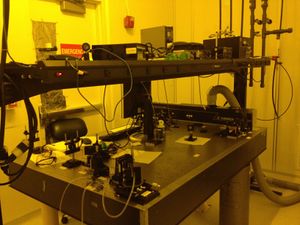Difference between revisions of "Holographic Lith/PL Setup (Custom)"
(→Detailed Specifications: minor updates to specs) |
(cusotme system, updated supervisor) |
||
| Line 2: | Line 2: | ||
|picture=Holograph.jpg |
|picture=Holograph.jpg |
||
|type = Lithography |
|type = Lithography |
||
| − | |super= |
+ | |super= Demis D. John |
| − | |phone=(805) 839-5689 |
||
|location=Bay 6 |
|location=Bay 6 |
||
| + | |description = Custom Interference Lithography |
||
| − | |email=Ningcao@ece.ucsb.edu |
||
| − | | |
+ | |manufacturer = Custom-Built Free-Space Optics |
| − | |manufacturer = Kimmon |
||
|toolid=35 |
|toolid=35 |
||
}} |
}} |
||
| Line 21: | Line 19: | ||
==Detailed Specifications== |
==Detailed Specifications== |
||
| − | *15 mW single TEM mode HeCd laser |
+ | *15 mW single TEM mode HeCd laser (Kimmon) |
*Max sample size: ~1.5 inch square uniform exposure area |
*Max sample size: ~1.5 inch square uniform exposure area |
||
| − | *~ |
+ | *~2 cm x 2 cm uniform exposure area |
| − | * |
+ | *Several-minute exposure times (manual shutter) |
*Grating period adjustable from ~200 to ~280 nm with rotation stage |
*Grating period adjustable from ~200 to ~280 nm with rotation stage |
||
*Manual optics alignment. |
*Manual optics alignment. |
||
Latest revision as of 20:48, 26 September 2023
|
About
The interference lithography system (aka. Holography) at UCSB uses a 15mW, single-mode, 325 nm HeCd laser that is filtered and expanded by pinhole filters to produce the large area exposure beam. The system uses a simple mirror configuration with a fixed 90 degree angle between the mirror and sample. The entire mirror/sample assembly is rotated in 0.1 degree increments to change the grating pitch from ~ 200 nm to ~ 280 nm (35 to 55 degrees) over an ~ 2 cm x 2 cm exposure area.
XHRiC bottom anti-reflection coating (BARC) & THMR-3600HP imaging resist spin-coated to ~80 nm thickness is used for grating exposure. 2-D gratings can be formed by rotating the sample and doing multiple exposures. Total exposure times are controlled by a manual shutter and are generally several minutes in length.
A photoluminescence measurement setup is co-located on the optical table. Please see the page for the PL system for more info:
Detailed Specifications
- 15 mW single TEM mode HeCd laser (Kimmon)
- Max sample size: ~1.5 inch square uniform exposure area
- ~2 cm x 2 cm uniform exposure area
- Several-minute exposure times (manual shutter)
- Grating period adjustable from ~200 to ~280 nm with rotation stage
- Manual optics alignment.
- 1-D and 2-D gratings possible, see recipes below.
Recipes
- Lithography Recipes > Holography Recipes - developed recipes for 1D (line/space) and 2D (pillars) gratings.
